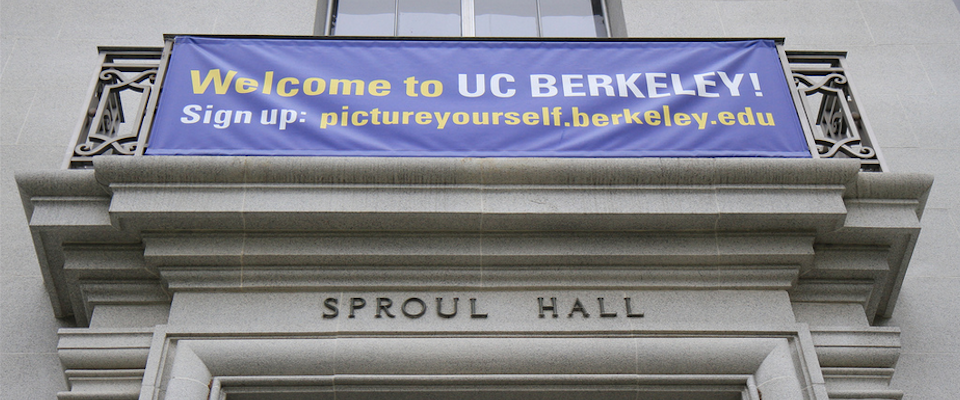A fourth-generation Cal grad wonders if there will be a fifth.
When my grandparents died and it was time to sell their Castro Valley home, I became the keeper of the University of California, Berkeley heirlooms. My great-grandmother’s 1919 yearbook. The wobbly blue-and-gold teddy bear my grandmother got when my mother was born. A set of 1943 Berkeley-edition Wedgwood plates, each depicting a campus building with the monumental drama of a Mount Rushmore print.
My grandmother Dorothy always pulled out the plates when I visited as an undergrad at Cal in the early ’90s. She couldn’t have been prouder. In addition to her mother, she, my grandfather, and her brothers were all Cal alumni, and my parents graduated from Berkeley in 1969.
Berkeley is practically the family religion, but I wonder if I will be the last disciple, the last to treasure Dorothy’s iconic keepsakes. Will my own daughters—the potential fifth generation of Cal women in my family—catch the Berkeley bug, and if they do, will they ever get in? They are now starting kindergarten and third grade at a San Francisco public school, and I can only hope that the state’s struggling education system will prepare them for entry to the country’s top public university.
Now that Berkeley is about as selective, and expensive, as elite private schools, what are the chances for a family like mine?
My husband and I are both journalists, and my grandparents and parents were civil servants, military officers and teachers. A look at the college experience of our solidly middle class family, reared for generations in California public schools, reveals how much things have changed at UC’s flagship campus.

My great-grandmother Ruth Pearson Gallison was alive until I was 10, and I remember hearing her stories about growing up as the youngest of ten siblings in a Swedish immigrant family. She moved from Gladstone, Minnesota, to Berkeley when her older sister Gerde offered room and board in exchange for help with her four young boys. Gerde lived in North Berkeley, right next to campus, and Ruth became one of over 6,000 students at Berkeley.
I often wondered why my great-grandmother went to college at a time when not many American women did. The answer, it turns out, is partly due to World War I. The university’s female enrollment in her junior year of 1917–18 was 53 percent, the highest percentage of women students until World War II, when it peaked at 63 percent.
In accordance with the state’s Organic Act of 1868, which established the University of California and guaranteed free tuition to all Californians, Ruth paid as little as $2 in annual fees. (Even then, the word “fee” rather than “tuition” was often used when discussing what students pay to attend UC schools.)
Ruth worked summers at Camp Curry in Yosemite National Park, where she met my great-grandfather Arthur Gallison, a park ranger. They married right after she finished college, and raised their three children in Yosemite Valley. My grandmother Dorothy started high school in Mariposa, then a couple hours’ drive away. Halfway through high school Dorothy moved to her aunt Gerde’s home in Berkeley, which had become a boarding house for students. Dorothy attended Berkeley High and then San Jose State University before transferring to UC Berkeley. Her brothers followed a similar path from San Jose State to UC.
“It was a big step going from Mariposa High, which had 120 students at the most, to go to Cal,” recalled my great-uncle Bob Gallison, who is 85. “But it wasn’t about cost.” At the time, there were more than 11,000 undergraduate students at Berkeley. When my grandparents graduated in 1942, fees were $55 per year.
Dorothy met my grandfather, Arthur Sprague, at the Christian Science Organization for Berkeley students before he went off to serve in World War II. Their oldest daughter, my mother, Jane, met my father, Michael Duggan, also at Berkeley’s Christian Science Organization during wartime. But my father was ideologically opposed to the Vietnam War, and when he received his draft card after graduating in 1969, he joined the Navy to avoid combat.
My father worked his way through college by flipping burgers at Doggie Diner every Sunday and full-time during summer. His union wages covered shared rent of a small house in the Oakland Hills, his car, books, and the quarterly college fees of $108. My mother had a slightly more modest lifestyle, in a small apartment next to campus, and her parents paid for her expenses.
My mother had no trouble transferring from UC Davis to Berkeley in her senior year, and my father says that he didn’t have to work very hard at Oakland High School to get into Berkeley as a freshman. They were beneficiaries of the 1960 Master Plan for Higher Education, the basic goal of which was to ensure a college education to anyone in California.
“Until the 1970s, UC Berkeley accepted all UC-eligible students. The campus was still growing,” said John Douglass, senior researcher at the Center for Studies in Higher Education at Berkeley. When my parents graduated, enrollment at Berkeley was at 18,000 undergraduates. Competition didn’t start in earnest until the mid-1970s, when the university reached its total enrollment goal of 30,000.
When I applied, most of my competition probably had an upwards of 4.0 GPA. I didn’t, but I had an interesting résumé. My father’s naval career brought us to the American embassy community in Bonn, Germany, where I learned German. Because the school I attended was tiny, I headed up several student groups.
I really wanted to go to Berkeley. As a child, my grandparents took my brother and me to campus for early indoctrination into the merits of the family alma mater. My grandmother often repeated the story of how my grandfather proposed in the Berkeley Rose Garden before he went off to serve in World War II, and my parents talked about dodging clouds of tear gas around campus. Berkeley was exciting and romantic.
I didn’t get in on my first try but was accepted as a second-semester freshman for the spring of 1990. My parents and grandparents covered most of my expenses and fees, which were around $1,300 in my freshman year; my rent was often less than $300 per month. I worked part-time on campus, and took out a $5,000 student loan. “We paid very little for you,” my father remembers. If my children end up at Cal, the costs will certainly not be as manageable, considering how much they have increased since I was a student, and how much they are projected to go up, even when adjusting for inflation. Registration and fees now cost $12,462 per year and the total estimated annual budget for a California resident is over $30,000.
Despite drastic class-size increases and staff reductions, the UC system’s budget gap is projected to reach $4.7 billion by 2019, the year my older daughter graduates from high school. State funding per student has decreased by more than half since I entered college 20 years ago. In 1990–91, the state spent an average of $15,860 per UC student compared to $7,570 last year.
The UC Commission on the Future recently looked at raising fees 4 percent per year starting in 2011–12, which, together with higher state contributions, could potentially lower the projected 2019 budget gap to $2.9 billion. If student fees do increase by that rate, my daughter’s annual fees would be more than $18,000 should she enroll in Berkeley in the fall of 2020.
It won’t matter how much Berkeley costs if my children can’t get in. Whereas 40 percent of applicants were accepted when I applied, around 26 percent were accepted for the current academic year and Douglass believes it will become even more difficult. The university may have to further reduce enrollment—something the state university and city college systems have already done—and has already implemented a plan to increase the total number of undergraduate nonresidents to 20 percent. This year’s freshman class is made up of 23 percent nonresidents, compared to 8 percent in 2007 and 14 percent in 2008. Though each nonresident pays an extra $22,000 in annual fees, financial concerns were not the only reason for this increase, said Susanna Castillo-Robson, Berkeley’s associate vice chancellor for admissions and enrollment.
“The chancellor [Robert J. Birgeneau] really was seeking to have a more geographically diverse population. It gives perspective in the classroom. And then the budget hit and that didn’t help matters at all,” said Castillo-Robson, who pointed out that other large state universities have bigger nonresident undergraduate populations, for example the University of Michigan at 34 percent.
Castillo-Robson said the University’s goal is to retain its blend of students that are around one-third low income, one-third middle income, and one-third high income. She believes the University’s demographic mix should be stable through 2020, though the percentage of Chicano and Latino students may increase as the state’s population shifts.
David Hollinger, a Preston Hotchkis Professor in the history department at Berkeley, put my family’s story in perspective. “In the past several decades we as a society have decided that almost everyone should go to college, with the result that families who were sending their children to college in the 1890s or 1930s are now joined by many families who were not attending college in those earlier times,” he wrote in an email. “Hence your daughters will be applying for college as part of a huge population in a knowledge-intensive society, very different from the one that produced your grandmother.”
Hollinger also pointed out that Californians of my grandparents’ and parents’ generations—as well as my own—helped create the educational budget crisis through their support of tax-averse legislators and ballot initiatives. For example, polls show that 69 percent of California voters support the continuation of Proposition 13, “despite decades of credible studies showing how Proposition 13 has crippled public education in this state.”
“California voters in earlier years, right down through the 1960s, enabled California’s universities to become among the best in the world because these voters were willing to pay for what a great university cost in 1930 or 1940 or 1950 or 1960,” he wrote. “In more recent years, they simply refuse to do this.”
So it is the state’s political culture, not University policies, that are responsible for UC’s budget crisis, argues Hollinger.
State senator (and former Berkeley mayor) Loni Hancock said the major problem is the two-thirds majority required both to pass a budget and to raise taxes in the state, which was implemented when Proposition 13 passed in 1978 (California is the only state that requires two-thirds majority for both). Because of this, she said that a minority of legislators can dictate priorities when it comes to funding decisions.
“It is a system that needs to change,” said Hancock, whose district includes Berkeley, Oakland, and most other East Bay cities. “We also need to recognize that government allows us to pull together what few of us can afford to by ourselves. We can’t build a bridge, we can’t build a great university alone. That’s one of the functions that we can allow government to do. And when we did, we were a magnet for the entire country and we were the envy of the world. Our public education system was a model.”
Despite the budget crisis, Berkeley maintains an excellent reputation.
Some will say that my desire to see my kids attend Berkeley comes from a sense of entitlement and an obliviousness to changes that have happened since my great-grandmother arrived in Berkeley almost a century ago. As Douglass pointed out, California was predominantly white and middle class until the 1970s, when immigration laws changed. The university has to serve all of the communities represented in the state, and mine is an increasingly smaller one. If my children do not get into Cal initially, they could always try transferring from another university, as many of my relatives did, or attend another UC campus or state university that is not as difficult to get into.
Yet my yearning for a fifth generation at UC Berkeley grows stronger as I watch my children play with Grandma’s Cal teddy bear. She died abruptly in 2002, just a week before my older daughter’s birth, but not before passing along the bear to me. The golden felt C on its chest is coming unstitched, and one eye is about to fall out. The girls do not yet understand the bear’s significance, but it could come in handy when they write their college applications. In the meantime, we had better work harder on their college savings fund.



















